
Many models to choose from.
Weaker 3w diodes.

Advanced LED Lights Inc. is a well-known company in the LED grow light industry. A lot of people have had successful grows using their products. Today I will review their Diamond Series lights as well as tell you a little bit more about the company.
Popular Lines of Lights
Most of my readers find it helpful to identify the lights being sold by a company before digging into the detailed review. In 2011, Advanced LED’s most popular lighting line was the Extreme Flower line. However, their newest lights are the Diamond Series lights. The Diamond lights will be their most popular lights in 2012 and are the lights that they are recommending to new customers.
The Diamond Series (DS) line comes with six different options (listed in the table below):
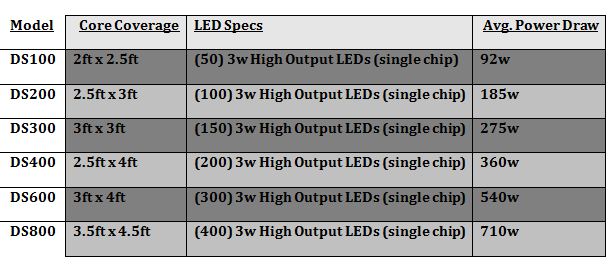
All of the lights are basically the same. The main difference between each of the lights within the line is the amount of power produced or watts drawn. For example, the DS 800 (actual watt draw 710) is obviously going to be physically bigger than the DS 100. The 800 module is also going to be a more powerful light and it will be able to grow more plants than the 100 module.
I love it when LED companies produce lines of lights like this because it allows you to be able to select the light that best fits your growing area.
My experience in this field tells me that the DS 200 will likely be their most popular light next year; closely followed by the DS 300.
Today we’ll review the DS 200W light, but keep in mind that this review will be applicable for all of the lights on the Diamond series.
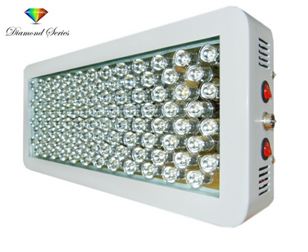
Diamond Series 200 – Unique Design
Price Range: A-
The DS 200 is currently priced at $500. That’s a lot of money for your average gardener, but it’s actually quite a great deal for those who are familiar with the LED growing industry. If we take a look at the price per watt then we’ll see that this light comes out at $500/185watts = $2.7 per watt. A few months ago I would have said that the industry average is around $6 per watt. However, the LED industry is evolving so rapidly that I’d say the new average for high-end lights like this one is around $4 per watt.
Warranty: A
The Advanced LED lights come with a 3-year manufacturer’s warranty. Paying $500 for a light that will last you at least three years isn’t a bad deal at all. Especially when you consider that a comparable HID light (400 watt HPS) would cost you $200 and only last you one year.
Returns and Refunds: A+
Advanced LED offers a 90 day trial period where you can test out the light and make sure it’s what you want. They get an A+ on their returns and refunds because they don’t ask that you document your grow in order to be able to send the light back. If you’re not satisfied, then just log on to their website, fill out a refund request, and ship the light back. The one thing that you will need to do is keep the original packaging of your light. You’ll need the original packaging in order to get a refund. Here are the complete details: http://www.advancedledlights.com/categories/Terms-%26-Conditions/
Actual Watts Drawn: B
You may want to read the following to understand why watt draw is important for LED grow lights. The DS 200 has an actual draw of 185 watts. I wish that LED manufacturers would clear up the confusion by labeling their lights according to their actual watt draw. Some other lights like the Penetrator and the Spectra do a better job of letting you know what type of light you are really getting.
I do like that Advanced LED is offering some extremely powerful lights and I think that the “core” coverage areas they list are reasonable. Their DS200 will probably provide you a true coverage area of about four square feet.
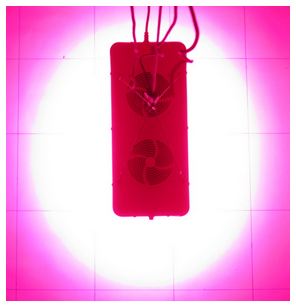
This light has large fans to help with cooling.
Heat Sinking System:B
Ensuring that an LED light has a good heat sinking system is extremely important. The lights are designed to last for 50,000 hours but they won’t make it that long without a good heat sink in place. I was happy to see that Advanced LED upgraded their heat sinks when they released their Diamond Series. LED manufacturers run into trouble when they try to produce a new, more powerful light without investing in a new heat sink.
I wanted to know more about their “new” heat sink so I asked them about it. Their response left me wanting more information:
Me: The website mentions an upgrade in the heat sink for the Diamond series. Any details on what the upgrade was?
Advanced LED: The heat sink is a dual heat sink which allows the unit to run cooler.
This interaction and other interactions I have had with Advanced LED have left me wondering how much the owners of the company know about LED lighting (more on this below where I talk about the company itself).
Color Ratio: A–
The Diamond Series 200 light has 11 wavelengths of color output (similar to other leaders in the industry): 760nm, 740nm, 720nm, 660nm, 630nm, 615nm-480nm, 460nm, 440nm, 415nm, 380nm.
Beam Angle: B+
The DS 200 uses ninety degree diodes. About three years ago the industry standard was 120 degree diodes. Since then manufacturers have realized that 120 degree beam angles didn’t provide enough penetration. Most of the leaders in the industry have moved to 60 or 90 degree beam angles that provide more focused and intense beams. I’d personally like to see Advanced LED mix in a couple of 60 degree diodes like some of the other leaders in the industry.
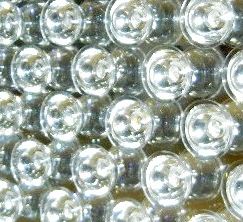
Here’s a look at their new diamond-shaped lenses.
New Diamond-Looking Diodes
I wish Advanced LED would tell us why their new Diamond-Looking diodes are better than their old diodes. I’m thinking that maybe the diamond diodes are an attempt to replicate the Penetrator series X-lens technology.
One thing that is better about the new DS diodes when compared to the Extreme Flower LEDs is that they are true 3-watt diodes instead of 3-watt, 3-chip diodes. See my post on 1w vs. 3w vs. 3w-3chip LEDs for more understanding.
The Company: ?
Advanced LED is a little more private than most of the other LED companies on the market. Their website indicates that they’re part of the Better Business Bureau (BBB) and that their headquarters are in Bentonville Arkansas. However, the website doesn’t tell us anything about who they are and why they have expertise in LED growing technology. I personally would like to know more about the credentials of this company. Do they have any botanists on the team? Do they make their lights in Arkansas or in China? What’s the history of the company?

Advanced LED is registered with the BBB under the name Market Smart
I have contacted Advanced LED multiple times asking for an interview, but they have always declined my invitations. They are, however, always willing to answer my questions about their lights.
Because they refused to be interviewed I had to put on my reporter hat and start doing some research. After digging around for a while, all I could find out about the company is that their incorporated name is actually Market Smart. Apart from LED grow lights, Market Smart also sells dog and cat furniture online. Basically this is an Internet Shopping company.
What does this mean? It could mean a lot of different things, but my guess is that the owners of this company aren’t scientists or botanists. They are probably Internet Marketers/Entrepreneurs who saw that the LED industry was growing and decided to hop aboard. This isn’t necessarily a bad thing. I assume that the owners have taken their time to learn all about LED technology. My guess would be that they don’t manufacture and design their own LED grow lights though. They probably work with companies in China to get that done.
Yes, I’m making a lot of assumptions here, but that’s what happens when a company refuses to be interviewed.
After talking with some other people in the industry I get the impression that perhaps Advanced LED is more of a follower than a leader. They try to replicate their competitors, but don’t spend much time or money in research and development themselves. This isn’t necessarily a bad thing from a consumer standpoint, but it does make me worry about the quality of their products.





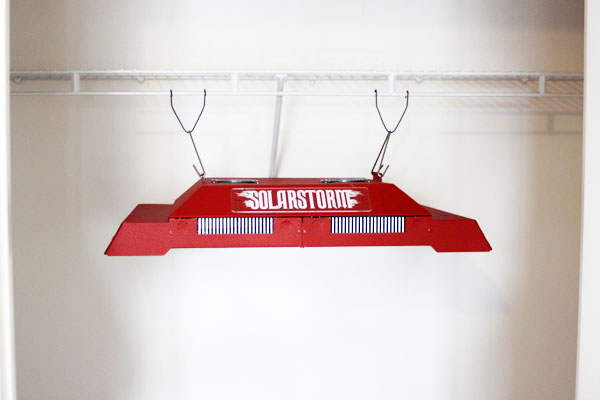
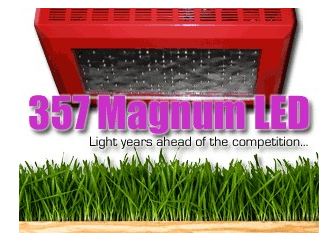
I have been looking at these lights. I am new to growing but I have been trying to do my research. After reading your review I have a few questions.
1. In most of the other light companies, if you take the actual number of bulbs and multiply it by three watts, their actual power consumption is usually around half of that and the ones from advanced are closer to around 10 percent shy. Does that mean they are using their diodes at maximum output and that they will in turn not last as long, or is it that they are wrong about the power consumption. And my biggest question about all of this is-
2. Isn’t the concern about the amount of light more about quality and intensity as opposed to the power consumption of the light. Don’t I really want to be more concerned with the lumens and spectrum in comparison to sunlight or HPS or HID, not about how much power it takes to operate it. Does power directly translate to energy the plant recieves?
3. I read your interview with California Lightworks and he said that wavelengths over 700 can actually be harmful to your plants. Is that true and do I need to worry about it with this fixture cause it says they have 3 wavelengths above 700?
4. Lastly when you were talking about their upgrade to their heatsink system and how they couldn’t explain it. Did you actually look at the system? Does it appear to stand up to your tests? If they offer a 3 year warranty , do you think that means I don’t need to worry about it cause they will replace it or are you more concerned that this company is just riding the wave of new technology and wont be around to back it up?
Hey Denise,
To respond to some of your comments/questions.
(1). That’s a great observation. I usually don’t make that calculation in my head when I’m evaluating a light, but it’s probably not a bad one to make to see if they are running the light too hot. Advanced offers a three year warranty (which is pretty good) so I’m not too worried about them offering a low quality product. Thanks for the great observation.
(2). This is a great point. I’ve got an article I wrote a while back that will point you in the right direction. Power consumption does matter, but PAR measurements using micromoles are what’s most important. Lumens aren’t the best measurement for plants because lumens measure light as it is perceived by the eye. Micromoles measure light as they are perceived by the plant. Here’s a great read on the subject: Understanding Watts, Amps, and Volts in LED Grow Lights
(3). I really respect George (the owner of California Lightworks) and he very well may be right, but I’ve also had other experts tell me that wavelengths over 700 can be beneficial for plants. I’ve grown with lights that claim to use wavelengths over 700 and they have worked great. I say “claim” because finding the exact spectra that a light is generating can be difficult work! I’m still saving up the $5,000 I’ll need to buy a spectroradiometer so we can really put these lights to the test! I’m thinking about putting a donate button up so I can get there sooner.
(4). If memory serves correctly I’ve seen photos of their heatsink. I think Advanced is a good company, but they aren’t as open with me as some of the other companies which does cause some concern on my behalf. I do think that Advanced will be around for the next few years and will be around to back up their warranties.
As I mention in the review, I think Advanced has some good lights. They aren’t my favorite because I have legitimate concerns about the people running the company. The lights do get the job done though.
Hope that helps. Thanks a lot for sharing your thoughts. Very helpful for the community.
Nate
Hi Nate,
I think you’re spot-on with this review. I’ve looked around the various LED Grow Light Review sites and must say I like yours the best. Over on My Hydro Gardening they have a review of the 126X-PRO prototype that Hydro Grow released early in 2011. It looks like Advanced has taken this design on as their own, calling it the “Diamond Series”. Many of us are familiar with Alibaba and can draw the conclusion that Advanced is ordering these from the same supplier that Hydro Grow used for the prototypes, which is likely E-Shine since they were the first to produce this light. I don’t see any development being done by Advanced, I just see “riding of the coat-tails” like you guessed. Their unwillingness to do an interview with you also warrants question to whether or not they truly know enough about their own products to answer your questions. Good looking out for the little guy!
Hey Donnie,
Thanks for your kind comments about the site. I really put a lot of time and effort into it so it makes me happy when I get a nice comment like this. I agree with your conclusions (brilliant minds think alike!). haha
I have a lot of plans in place to make this site even more valuable for the little guy.
Best,
Nate
Hey Nate and fellow readers,
Nate you are the man when it comes to wanting information on LEDS this is the place to come and read. Unfortunatley I made the mistake of buying lights before doing allot of home work and ending up buying from this company. Don’t get me wrong they do work and I have had some results with them but was a bit angry with the way the went on about being a USA company and when I ordered my lights it took them a very long time to come and on top of that they came from CHINA. I know everything gets made in CHINA these days but ADVANCE never mentioned that to me they always went on about their USA LED technology.
Like I said they the lights are not that bad but after doing allot of reading on here and some research with pricing you can probably find a better deal with another light that will do the same job if not better. Just my thoughts.
Keep up the fantastic work Nate we are all extremly happy with you sharing your wisdom on lighting with us and helping first time growers and buyers understand how important light really is.
Hey Dave,
Thanks for the kind words. It makes all the time I put into this site worthwhile.
Nate
THIS WAS THE REPLY I GOT FROM THE COMPANY REGARDING WHETHER THE LIGHTS WERE MADE IN AMERICA OR NOT………
Yes the order is shipping from our factory in Hong Kong, we are a U.S.A. company and our design is from us. However for our light we do have them put together in Hong Kong because the housing is so expensive in the U.S.A. and it would raise the prices $300.00 per unit. Rest assured the product is made to our specifications, we have all of our led’s, fans, power supplies for out light imported over to our factory and when you receive the product you will breath better when you see the quality is U.S.A. quality and not a cheap China product.
The in-house quality checks are for Domestic shipments for the U.S.A. and not for international shipping, I am sorry for the confusion on that. However rest assured on each international order I am always talking to the manager of our factory and we have a checklist that has to be followed on each light and they do the same checklist over a Skype video chat that I monitor, so rest assured that they do check the light as we check it as well.
I HAVE FOUND THE COMPANY TO BE MOST HELPFUL AND HAVE ANSWERED ALL OF MY QUESTIONS HONESTLY.
I HAVE PURCHASED A UNIT AND WILL BE TESTING IT SOON…. WILL LET YOU KNOW HOW I GET ON.
Hey Nate,
First of all I have to join the chorus about this website: since I put my son to bed I’ve spent 2.5 hours doing research for my grow closet. At the moment I’m using CFLs (4 at 60 watts each). In a closet you can imagine that as the temperature rises outside so does the temp inside my little closet. It’s starting to affect my crop and I decided it’s time to upgrade–the CFL’s never gave much of a yield anyway.
Firstly I’m deciding between the Diamond Series 100w and the 240w Hydro BlackStar Flowering light. It would seem that the Blackstar is more powerful but your review says it’s best for flowering: will it do well for vegging and cloning? What would you predict the difference would be between using just the flowering light and using the veg light in combo with the flowering light (i can’t afford both–looking for 1 light to do the job in a small space filled with budding clones). The Diamond Series boasts a switch to adjust wavelength outputs so it can specialize in veg, flowering, and cloning with the flip of a switch.
Personally it seems like the BlackStar has more wattage with a better review of the company and for a cheaper price. I’m leaning towards it: but I want to be sure it will be able to be versatile for all my needs. You seem to have all the knowledge i’ve been trying to gain on my own: so which do you think is the best option? Thanks.
Hey Nick,
First off, thanks for your kind words about my website. People like you are the reason I keep spending all my spare time on this site! That and I’m addicted to growing indoors with LEDs.
I’d go with the 240w blackstar flowering light. It will do just fine during veg. I have a bad tendency to talk a lot more about flowering than vegging on this site because I assume that everyone already knows that LEDs are amazing during the vegetative phase. If you’re using one light to grow a plant then always go with the flowering light when dealing with LEDs.
The only concern I have with your setup is that your clones won’t be getting the recommended 18 hours of light to keep them in the vegetative phase. The general rule of thumb is to switch to 12 hours of light when flowering. You can probably make it work, but keep that in mind.
Best,
Nate